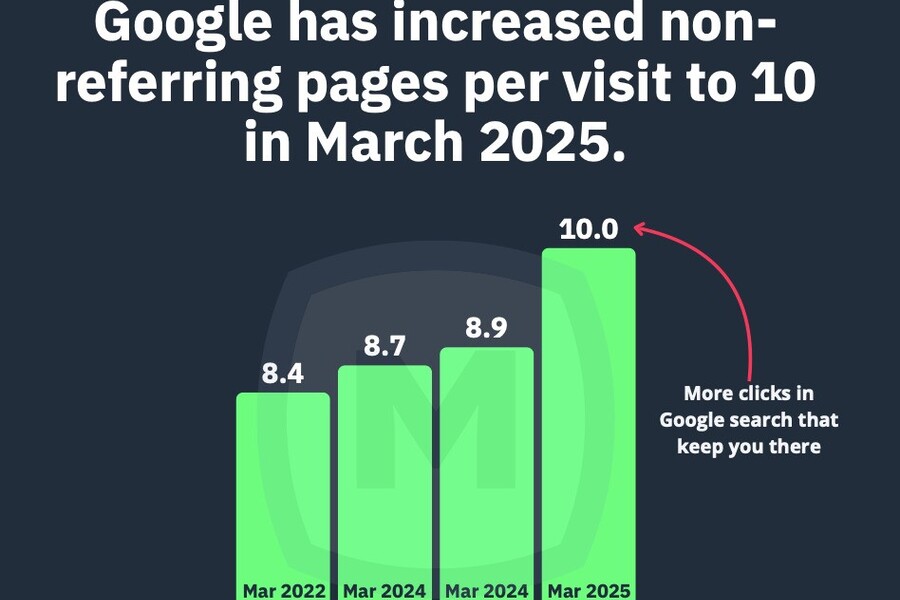Google’s “Walled Garden” Widens as Users Click Ten Times Before Departing

A new 13‑month study reveals that Google is not only the dominant source of web traffic but increasingly succeeds in keeping visitors within its own “walled garden” of search results, where users now click an average of 10 times on Google’s domain before navigating to an external site. In contrast, ChatGPT users, though fewer in number, are 2.3 times more likely to leave the platform per session, highlighting a growing efficiency gap between traditional search engines and AI chatbots.
The analysis, conducted by Tyler Einberger of Momentic and based on Similarweb data, tracks user behavior on Google.com versus ChatGPT over 13 months through March 2025. It focuses on two key metrics: the number of clicks users make within the platform before exiting and the rate at which each platform drives traffic to external websites. By measuring both absolute traffic and per‑user referral rates, the study offers insight into how each service balances its dual roles as destination and gatekeeper.
As of March 2025, Google users average 10 pages per visit,” a metric that has climbed steadily over the past year. This rise signals that Google’s suite of in‑search features—such as instant answer boxes, image carousels, interactive maps, and refined search controls—is compelling users to remain within Google’s ecosystem. Each interaction, whether paging through results, toggling filters, or clicking on rich media, changes the URL without leaving Google’s domain.
Despite this, Google still sends more total traffic to outside websites than any other platform: 175.5 million outgoing visits in March, compared to ChatGPT’s 57.6 million. However, when looking at referral efficiency, ChatGPT outperforms Google by a wide margin. ChatGPT users generate an average of 1.4 external clicks per session, whereas Google users produce just 0.6. In other words, ChatGPT is 2.3 times more likely to send any given user to an external site, even though Google’s audience is nearly seven times larger.
Over the past year, Google’s outgoing traffic grew by 66.4%, yet its overall audience size has remained nearly flat. This suggests that while Google continues to dominate as the web’s primary gateway, its expanded in‑platform engagement is simultaneously limiting the proportion of users who click through to publisher sites.
For marketers and SEO professionals, these findings present both challenges and opportunities. The months‑ahead battle for visibility will hinge on securing prime placement in Google’s evolving interface—featured snippets, knowledge panels, People Also Ask boxes, and other rich result formats. Traditional organic rankings alone may no longer guarantee clicks. At the same time, AI chat platforms like ChatGPT deserve a seat at the table: their higher per‑user referral rates mean they can be valuable sources of traffic, especially for content optimized to satisfy direct-answer queries.
Meanwhile, other AI search engines are scaling rapidly. Perplexity saw user growth of 110.7% month‑over‑month in March, Grok grew by 48.1%, and Claude by 23%. Although this particular study does not evaluate their referral efficiency, these surging alternatives could further alter traffic dynamics as they mature.
Looking forward, Google’s “in‑SERP” arsenal is likely to expand even further—embedded video previews, interactive timelines, live data widgets, and more. Each added feature deepens Google’s walled garden, making on‑platform engagement stickier. Publishers must adapt by crafting content that earns Google’s direct‑answer slots and by forging diversified traffic strategies that include AI chatbots and emerging search services.
In sum, Google remains the internet’s most powerful traffic engine, but its success at keeping users clicking within its own domain comes at the cost of referral efficiency. As content consumption habits evolve, the most forward‑thinking brands will optimize for both in‑SERP prominence and multi‑channel traffic generation, ensuring they capture audiences wherever they choose to click next.
